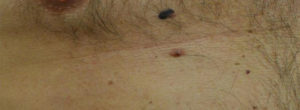As the sun comes out of its hibernation, it’s the time of year when we will be taking off the extra layers of clothing to allow the sunshine on our skin. For dermatologists this is a busy time when those funny looking moles grab the attention of patients and their partners. The ‘ugly duckling sign’ refers to identification of moles which stand out as being distinctly different in appearance. This is an important sign which dermatologists use to identify ‘melanoma’, which is a type of skin cancer, in patients who have many moles. Some patients may have hundreds of moles and are referred to as having the ‘atypical naevus syndrome’ where the ‘ugly duckling sign’ is of particular relevance.
How frequently should I undergo a mole check?
For those who have only a few moles and low risk of melanoma (no personal or family history of melanoma, no history of sun bed use or excessive sun exposure, dark skin) a self-skin examination once every few months would suffice. On the other hand, patients who have the atypical naevus syndrome, previous history of skin cancer/s, strong family history of skin cancers, fair skin, suppressed immunity or history of excessive sun exposure, I would recommend once monthly self-skin examination. Good quality digital pictures of the moles should be taken at baseline.
How do you differentiate an innocent mole from one which is melanoma?
The popular ‘ABCDE’ method comes in handy when assessing moles against baseline photos.
A= Asymmetric. Each one half of the mole differs from the other.
B= Border. A mole with uneven or notched border.
C= Colour. A mole with different shades of grey, black, brown, red, white or blue.
D= Diameter. A mole which is 6mm or more in its diameter.
E= Evolution. A mole which appears larger than the baseline pictures.
I also add an ‘F’ to this mnemonic.
F= Funny symptoms of itching, bleeding, crusting and discomfort in a mole are unusual and should never be disregarded.
What to expect when you see a dermatologist?
If you have any of the alarming signs, you should seek advice from your GP who can refer you to a dermatologist. Any suspicious mole should be examined by a dermatologist who would undertake a full-body skin examination and a dermatoscopic examination of the moles to look for signs of melanoma. Dermatologists are trained to use these hand held illuminated magnifiers which highlight specific signs of melanoma which may not be apparent to the untrained eyes.
Professor Vishal Madan is a Consultant Dermatologist at The Wilmslow Hospital, 52 Alderley Road., Bridgewater Hospital Manchester, BMI The Beaumont Hospital.

